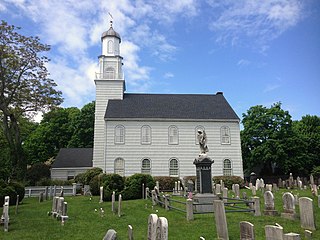 W
WThe Battle of Setauket was a failed attack during the American Revolutionary War on a fortified Loyalist outpost in Setauket, Long Island, New York, by a force of Continental Army troops from Connecticut under the command of Brigadier General Samuel Holden Parsons.
 W
WThe Battle of Bennington was a battle of the American Revolutionary War, part of the Saratoga campaign, that took place on August 16, 1777, in Walloomsac, New York, about 10 miles (16 km) from its namesake, Bennington, Vermont. A rebel force of 2,000 men, primarily New Hampshire and Massachusetts militiamen, led by General John Stark, and reinforced by Vermont militiamen led by Colonel Seth Warner and members of the Green Mountain Boys, decisively defeated a detachment of General John Burgoyne's army led by Lieutenant Colonel Friedrich Baum, and supported by additional men under Lieutenant Colonel Heinrich von Breymann.
 W
WThe Boyd and Parker ambush was a minor military engagement in Groveland, New York on September 13, 1779, during the American Revolutionary War. A scout group of the Sullivan Expedition was ambushed and captured by Loyalists and their Seneca Indian allies led by Little Beard.
 W
WThe Cherry Valley massacre was an attack by British and Iroquois forces on a fort and the village of Cherry Valley in central New York on November 11, 1778, during the American Revolutionary War. It has been described as one of the most horrific frontier massacres of the war. A mixed force of Loyalists, British soldiers, Seneca and Mohawks descended on Cherry Valley, whose defenders, despite warnings, were unprepared for the attack. During the raid, the Seneca in particular targeted non-combatants, and reports state that 30 such individuals were slain, in addition to a number of armed defenders.
 W
WThe Battle of Cobleskill was an American Revolutionary War raid on the frontier settlement of Cobleskill, New York on May 30, 1778. The battle, having taken place in the modern-day hamlet of Warnerville, New York, near the modern (2019) Cobleskill-Richmondville High School, marked the beginning of a phase in which Loyalists and Iroquois, encouraged and supplied by British authorities in the Province of Quebec, raided and destroyed numerous villages on what was then the United States western frontier of New York and Pennsylvania.
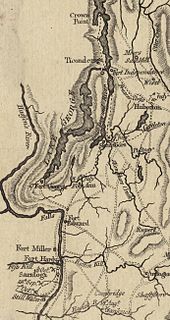 W
WThe Battle of Fort Anne, fought on July 8, 1777, was an engagement between Continental Army forces in retreat from Fort Ticonderoga and forward elements of John Burgoyne's much larger British army that had driven them from Ticonderoga, early in the Saratoga campaign of the American Revolutionary War.
 W
WThe Battle of Fort Slongo was fought on October 3, 1781 between American Continental Army forces, under the command of Benjamin Tallmadge and Lemuel Trescott, and the British defenders of Fort Salonga, in the American Revolutionary War. The fort was located near the border of present-day Huntington Township and Smithtown, New York, overlooking Long Island Sound.
 W
WThe Battle of Fort St. George was the culmination of a Continental Army raiding expedition led by Benjamin Tallmadge against a fortified Loyalist outpost and storage depot at the Manor St. George on the south coast of Long Island on November 23, 1780, during the American Revolutionary War. Tallmadge's raid was successful; the garrison was surprised, and many provisions and prisoners were taken.
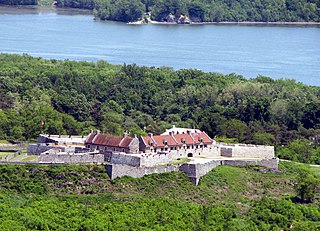 W
WThe 1777 Siege of Fort Ticonderoga occurred between the 2nd and 6 July 1777 at Fort Ticonderoga, near the southern end of Lake Champlain in the state of New York. Lieutenant General John Burgoyne's 8,000-man army occupied high ground above the fort, and nearly surrounded the defenses. These movements precipitated the occupying Continental Army, an under-strength force of 3,000 under the command of General Arthur St. Clair, to withdraw from Ticonderoga and the surrounding defenses. Some gunfire was exchanged, and there were some casualties, but there was no formal siege and no pitched battle. Burgoyne's army occupied Fort Ticonderoga and Mount Independence, the extensive fortifications on the Vermont side of the lake, without opposition on 6 July. Advance units pursued the retreating Americans.
 W
WThe Battle of Forts Clinton and Montgomery was an American Revolutionary War battle fought in the Hudson Highlands of the Hudson River valley, not far from West Point, on October 6, 1777. British forces under the command of General Sir Henry Clinton captured Fort Clinton and Fort Montgomery, and then dismantled the first iteration of the Hudson River Chain. The purpose of the attack was to create a diversion to draw American troops from the army of General Horatio Gates, whose army was opposing British General John Burgoyne's attempt to gain control of the Hudson.
 W
WThe Attack on German Flatts was a raid on the frontier settlement of German Flatts, New York during the American Revolutionary War. The attack was made by a mixed force of Loyalists and Iroquois under the overall command of Mohawk leader Joseph Brant, and resulted in the destruction of houses, barns, and crops, and the taking of livestock for the raiders' use. The settlers, warned by the heroic run of Adam Helmer, took refuge in local forts but were too militarily weak to stop the raiders.
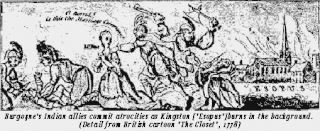 W
WThe Burning of Kingston, New York, took place on October 17, 1777, during the American Revolutionary War as part of the Saratoga Campaign.
 W
WThe Meigs Raid was a military raid by American Continental Army forces, under the command of Connecticut Colonel Return Jonathan Meigs, on a British Loyalist foraging party at Sag Harbor, New York on May 24, 1777 during the American Revolutionary War. Six Loyalists were killed and 90 captured while the Americans suffered no casualties. The raid was made in response to a successful British raid on Danbury, Connecticut in late April that was opposed by American forces in the Battle of Ridgefield.
 W
WThe Battle of Minisink was a battle of the American Revolutionary War fought at Minisink Ford, New York, on July 22, 1779. It was the only major skirmish of the Revolutionary War fought in the northern Delaware Valley. The battle was a decisive British victory, as the colonial militia was hastily assembled, ill-equipped, and inexperienced.
 W
WThe Battle of Newtown was a major battle of the Sullivan Expedition, an armed offensive led by General John Sullivan that was ordered by the Continental Congress to end the threat of the Iroquois who had sided with the British in the American Revolutionary War. John Butler and Joseph Brant did not want to make a stand at Newtown, but proposed instead to harass the enemy on the march, but they were overruled by Sayenqueraghta and other Indian chiefs. The Battle of Chemung was the only other major battle of the Sullivan Expedition where the Continental force lost six dead and nine wounded.
 W
WThe Battle of Oriskany was one of the bloodiest battles in the American Revolutionary War and a significant engagement of the Saratoga campaign. On August 6, 1777, a party of Loyalists and several hundred Indigenous allies across several nations ambushed an American military party that was marching to relieve the siege of Fort Stanwix. This was one of the few battles in which the majority of the participants were Americans; Patriots and allied Oneidas fought against Loyalists and allied Iroquois in the absence of British regular soldiers. There was also a detachment of Hessians in the British force, as well as Western Indians including members of the Mississauga people.
 W
WThe Raid on Unadilla and Onaquaga was a series of military operations by Continental Army forces and New York militia against the Iroquois towns of Unadilla and Onaquaga in what is now upstate New York. In early October 1778, more than 250 men under the command of Lieutenant Colonel William Butler of the 4th Pennsylvania Regiment descended on the two towns and destroyed them, razing most of the buildings and taking or destroying provisions, including the people's winter stores.
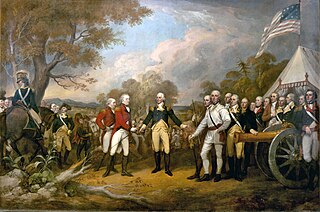 W
WThe Battles of Saratoga marked the climax of the Saratoga campaign, giving a decisive victory to the Americans over the British in the American Revolutionary War. British General John Burgoyne led a large invasion army southward from Canada in the Champlain Valley, hoping to meet a similar British force marching northward from New York City and another British force marching eastward from Lake Ontario; the goal was to take Albany, New York. The southern and western forces never arrived, and Burgoyne was surrounded by American forces in upstate New York 15 miles short of his goal. He fought two battles which took place 18 days apart on the same ground, 9 miles (14 km) south of Saratoga, New York. They both failed.
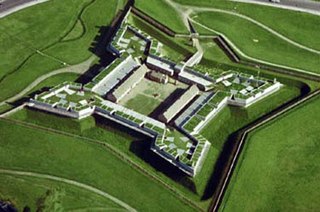 W
WThe siege of Fort Stanwix in 1777 began on August 2 and ended August 22. Fort Stanwix, in the western part of the Mohawk River Valley, was then the primary defense point for the Continental Army against British and Indian forces aligned against them in the American Revolutionary War. The fort was occupied by Continental Army forces from New York and Massachusetts under the command of Colonel Peter Gansevoort. The besieging force was composed of British regulars, American Loyalists, Hessian soldiers from Hesse-Hanau, and Indians, under the command of British Brigadier General Barry St. Leger and the Iroquois leader Joseph Brant. St. Leger's expedition was a diversion in support of General John Burgoyne's campaign to gain control of the Hudson River Valley to the east.
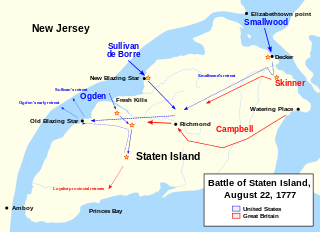 W
WThe Battle of Staten Island was a failed raid by Continental Army troops under Major General John Sullivan against British forces on Staten Island on August 22, 1777, during the American Revolutionary War. After British Lieutenant General William Howe sailed with most of his army from New York City in July, Sullivan recognized that the British position on Staten Island was vulnerable, and planned an attack. He carried it out in spite of commanding general George Washington's request that Sullivan reinforce the main army with his troops as soon as possible to support Washington's planned Colonial assault on British-held Philadelphia.
 W
WThe Battle of Stony Point took place on July 16, 1779, during the American Revolutionary War. In a well planned and executed nighttime attack, a highly trained select group of George Washington's Continental Army troops under the command of Brigadier General "Mad Anthony" Wayne defeated British troops in a quick and daring assault on their outpost in Stony Point, New York, approximately 30 mi (48 km) north of New York City.
 W
WThe capture of Fort Ticonderoga occurred during the American Revolutionary War on May 10, 1775, when a small force of Green Mountain Boys led by Ethan Allen and Colonel Benedict Arnold surprised and captured the fort's small British garrison. The cannons and other armaments at Fort Ticonderoga were later transported to Boston by Colonel Henry Knox and used to fortify Dorchester Heights and break the standoff at the siege of Boston.
 W
WThe Battle of Valcour Island, also known as the Battle of Valcour Bay, was a naval engagement that took place on October 11, 1776, on Lake Champlain. The main action took place in Valcour Bay, a narrow strait between the New York mainland and Valcour Island. The battle is generally regarded as one of the first naval battles of the American Revolutionary War, and one of the first fought by the United States Navy. Most of the ships in the American fleet under the command of Benedict Arnold were captured or destroyed by a British force under the overall direction of General Guy Carleton. However, the American defense of Lake Champlain stalled British plans to reach the upper Hudson River valley.